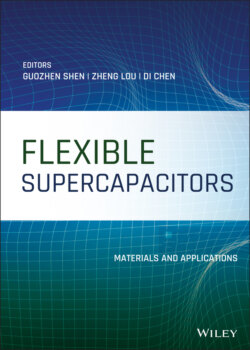Читать книгу Flexible Supercapacitors - Группа авторов - Страница 38
2.2.3.2 Editable SCs
ОглавлениеEditable SCs can be directly transferred into arbitrary shapes with stretchability along arbitrary direction. Figure 2.12a–c provided a mature method to prepare arbitrary CNT based electrode materials [74]. Figure 2.12a showed the schematics of out‐of‐plane deformation of 3D stretchable SCs. To obtain the SWCNT with pyramid structure, the pyramid catalyst containing 5 nm thick of Al2O3 and 1.2 nm thick of Fe was sputtered on the silicon wafer by photolithography and electron beam evaporation deposition. Then the aligned CNT array was synthesized on the silicon by employing CVD method. Finally, the PANI was deposited on the CNT film via electrochemical deposition to improve the specific capacitance of the electrode materials. Figure 2.12b showed the optical images of the CNT film with increasing strain along the z axis. From the images, we can see the structure and integrity of the CNT film was not damaged during the stretching process. The stretchable SCs were assembled by two pieces of PANI@CNT film and a PVA/H3PO4 gel electrolyte in the middle. The specific capacitances of the fabricated stretchable SCs calculated from the charge–discharge curves reached an areal capacitance of 61.4 mF cm−2, which was maintained at 93.3% after 3000 strain‐release cycles along the y and z axes. Figure 2.12c displayed the gavanostatic charge–discharge profiles of the fabricated stretchable SCs with increasing strains from 0% to 16% along the x and y axis. It can be seen that there is no degradation in both charge–discharge time and operation voltage window, showing an outstanding stability under stretching.
Figure 2.12 (a) Schematics of a 3D stretchable SC. (b) Optical images of the CNT film being gradually stretched along the z axis. (c) GCD curves with increasing strains from 0% to 16% along the x or y axis.
Source: Reproduced with permission [74]. © 2016, The Royal Society of Chemistry.
(d) Schematics for the assembling process of stretchable SCs. (e) Digital images of 3D SCs under different strain tests. (f) Lighting test driven by tailored paper‐cutting SC.
Source: Reproduced with permission [41]. © 2017, Wiley‐VCH.
By the kirigami technique, the SCs can be designed with stretchability, as shown in Figure 2.12d [41]. In comparison with prestrain‐release based stretchable SCs, the form and shape of editable are more free. Cellular structure, pyramid structure, living‐hinge structure etc. can be easily obtained and the stretchable direction are not restricted. Traditional sandwiched SCs always use gel electrolyte as the separator, which caused the weak intermolecular interaction thus cannot effectively serve as a separator to prevent short circuit of SCs during editing process. Therefore, the authors employed nanocellulose fibers as separator and PVA/H3PO4 as gel electrolyte. MnO2 nanowires@CNT served as electrode materials. Figure 2.12e displayed the photography of fabricated honeycomb shaped SCs with increasing strain varying from 0% to 810%. The fabricated honeycomb shaped SCs exhibited a specific capacitance of 227.2 mF cm−2 and no degradation of electrochemical performance when applied a strain of 500%, providing an excellent mechanical stability of the editable SCs. In addition, nearly 98% of initial capacitance of the honeycomb shaped editable SCs interlocked by PU fibers was remained even after 10 000 stretch‐and‐release cycles under reversible 400% tensile strain. As mentioned above, the editable SCs endow advantages of tunable voltage by different interconnection in parallel and/or series. As a proof of concept, four SCs were connected in series and tailored into delicate and artistic patterns to power a LED (Figure 2.12f), suggesting that editable SCs can realize more complicated and free patterns with high stretchability.
